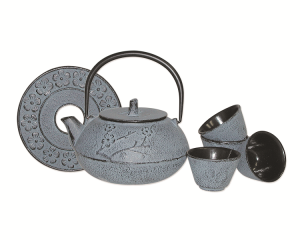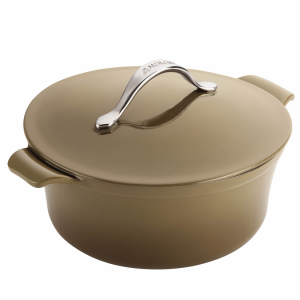Cast Iron
Smithey’s Farmhouse Oval Roaster
Smithey Ironware Company‘s newest item in its line of hand-forged carbon steel cookware is the Farmhouse Oval Roaster, which will retail for $275 when it goes on sale in September, 2020.
Inspired by American blacksmith technique of the 18th century, this brand-new oven-to-table roaster is designed in collaboration with renowned Charleston blacksmith Robert Thomas.
 Each one of these hand-forged, limited-edition roasters is unique—from the hand-hammered handles to the highly polished interior. Carbon steel offers stovetop and oven-safe cooking performance that rivals cast iron at a lighter weight, making this not only a beautiful serving piece but a kitchen workhorse, perfect for roast chicken, fish, gratins, vegetables and more.
Each one of these hand-forged, limited-edition roasters is unique—from the hand-hammered handles to the highly polished interior. Carbon steel offers stovetop and oven-safe cooking performance that rivals cast iron at a lighter weight, making this not only a beautiful serving piece but a kitchen workhorse, perfect for roast chicken, fish, gratins, vegetables and more.
The Farmhouse Oval Roaster is hand-forged in Charleston, North Carolina and comes with a pre-seasoned natural finish free of any chemical coatings. It’s designed for use on gas, electric or induction stoves or even over the campfire. It measures 13.5 inches across (16.5 inches handle to handle) and weighs approximately 6 pounds. It’s a companion to Smithey’s best-selling Farmhouse Skillet.
Cast Iron Teapots from SCI
 SCI (Scandicrafts Cuisine Internationale) carries an impressive collection of artistically crafted cast iron teapots. Each teapot is designed with exquisite detail. All uniquely display a warm sense of tradition with a contemporary flair.
SCI (Scandicrafts Cuisine Internationale) carries an impressive collection of artistically crafted cast iron teapots. Each teapot is designed with exquisite detail. All uniquely display a warm sense of tradition with a contemporary flair.
Each of SCI’s teapots comes with a matching cast iron trivet. Some sets also include matching teacups. Each teapot includes a removable stainless steel mesh infuser, making it perfect for both loose leaves and tea bags.
Cast iron teapots are ideal since the cast iron distributes the heat evenly inside the pot to better extract the flavors and health benefits of your tea. A distinctively appealing taste is acquired only from brewing tea in a cast iron teapot. Cast iron teapots develop a seasoning from repeated use, producing richly flavored cups of tea that are each more delicious than the last.
Suggested retail prices range from $63.00 to $80.00.
Small Batch Cast Iron
By Micah Cheek
Even in a world of advanced nonsticks and lightweight aluminum saute pans, cast iron maintains a strong presence for functionality and strength. There is a whole internet subculture dedicated to finding and restoring vintage cast iron, in part because vintage cast iron was polished to a smooth finish after being cast. This increased the cast iron’s nonstick properties, but significantly raised the cost of production. Gradually, consumers turned to less expensive options with a rougher, more pebbly texture. Now, consumers are looking for higher quality cast iron with a more refined surface.
One cast iron producer, Stargazer Cast Iron, was started out of an interest in vintage cookware. “I got into cast iron as a hobby, I was collecting it and obsessing with it,” says Peter Huntley, Chief Executive Officer of Stargazer. “I thought I had something to contribute here. Even with the vintage ones, there were some design changes to be made, so that’s where my design came from.” Huntley used his background in both design and dinnerware industries to build his ideal pan from the ground up. One big factor was the smooth surface that older designs had. “I had experimented at home with different materials. It seemed attainable to me. It seemed like the kind of thing that should be done in production rather than the end user having to,” says Huntley. “The surface finish is what got the ball rolling, but we’ve made some other changes. One of them is weight. We kept weight in mind in every step of the process. The weight of cast iron is what makes it retain heat, but we’ve made it very manageable.”
Luke Trovato, Chief Marketing Officer of Stargazer, notes that the growing market for high end cast iron has to do with utility and sourcing. “Initially we were figuring out which demographic would be there, we’ve found that we sell across all demographics, a lot of people are interested in American-made products,” says Trovato. “It’s branched out a bit. We haven’t had a ton of advertising, but it’s definitely growing from the cast iron group. There are some people who are looking for their first cookware. A younger crowd buying cookware for the first time is looking for a workhorse for the kitchen. There’s a rededication for cast iron, so that’s something we’re looking to build on.”
The folks at Stargazer were also surprised to find how often cast iron was being bought as a gift. “From the social media aspect, it caught on and people spread the word. When people get their orders, there’s a ripple effect out of that,” says Trovato. “We’ve had people who get theirs, like it, and then buy a couple more as gifts.” The community that forms around cast iron is also always looking for new ways to cook with the material. “Dutch ovens and griddles are popular ones, we’ve had requests for a wok as well. We’ve had requests for lids, we’re looking at something like a universal lid that can fit everything,” says Trovato. “Some guy wanted some huge pot from us, he even gave us dimensions and it was enormous.”
New buyers of small batch cast iron might be confused at the color of the cookware that comes out of the box. The deep black color of most cast iron comes from two stages of production. After the casting process, mass produced pieces aren’t polished and retain a rough finish. After that, preseasoning takes place. At an assembly line, a thick layer of seasoning oil is applied by a sprayer and treated at high heat to speed up the process of seasoning. These factors combine to make the dark grey and black surfaces that cast iron is known for. But, Trovato notes, this doesn’t have to be the case. Stargazer’s polishing and hand-seasoning makes a pan that looks different from mass produced models. Stargazer pans have thin, hand-applied layers of oil seasoned at a lower heat, which makes the finished pans distinctly lighter in color. “Ours start a little bronzer. People are curious about why it looks different. A lot of people don’t realize it starts silver, just like any other metal, and as you cook with it more it’ll turn black,” says Trovato.
Another appeal of cast iron is a distrust of nonstick cookware. “You’ve seen a lot more concern about where [customers’] foods come from. Those concerns tie into the health concerns around nonstick coatings,” says Trovato. “I’ve had more than a couple customers mention things like ‘space age nonstick coating,’ there’s some skepticism around it. The more natural feel of cast iron is something that really appeal to them.” Consumers are also looking for something that will last longer. “I do think in general there’s a shift away from disposability, people will know they’re going to be replacing [aluminum nonstick pans] in two years,” says Trovato. “If they invest in cast iron they’re never going to replace it. People just want something more permanent.”
Meyer Debuts Anolon Vesta Cast Iron and Stoneware in New Umber
 Following the success of Anolon® Advanced™ Umber, a rich brown hue offered in Anolon hard anodized cookware, Umber is the newest color addition to Anolon Vesta™ Cast Iron cookware and Anolon Vesta Stoneware. The new Umber color in Vesta Cast Iron and Vesta™ Stoneware will be available at retail nationwide in June 2017.
Following the success of Anolon® Advanced™ Umber, a rich brown hue offered in Anolon hard anodized cookware, Umber is the newest color addition to Anolon Vesta™ Cast Iron cookware and Anolon Vesta Stoneware. The new Umber color in Vesta Cast Iron and Vesta™ Stoneware will be available at retail nationwide in June 2017.
Anolon Vesta Cast Iron cookware merges cast iron’s superior durability and heat retention with distinctive stovetop-to-oven-to-table style and performance. The nonreactive, matte black enamel cooking surface resists stains and does not require seasoning, while the beautiful porcelain enamel exterior – now offered in rich, warm Umber – is both easy to clean and beautiful to display. The self-basting lid features a nubbed-interior for natural redistribution of flavorful cooking liquid back into the pot for continuous self-basting properties. The lid also features an elegant and generously proportioned stainless steel handle large enough to fit an oven mitt. Similarly, side handles are styled with a wide flare to make them easier to hold. For the ultimate in versatility and convenience, each item in the collection is suitable for all ranges, including induction cooktops, and is oven safe to 500 degrees Fahrenheit.
Anolon Vesta Cast Iron cookware in new Umber is offered in a 10-inch Skillet; 12-inch Skillet; 4 Quart Oval Dutch Oven; 5 Quart Covered Braiser; 5 Quart Round Covered Dutch Oven and 7 Quart Round Covered Dutch Oven. Other colors offered in Anolon Vesta Cast Iron include Paprika Red and Cobalt Blue.
Complementing Anolon’s cast iron cookware is the elegantly styled Anolon Vesta Stoneware collection of durable oven-to-table bakers, casseroles, ramekins, and more. Made of non-reactive and stain-resistant stoneware with a rich glaze in solid hues, each item features sturdy flared side handles for easy lifting and carrying from the oven or cook top to the table. All items are dishwasher, microwave and freezer safe, and oven safe up to 500 degrees Fahrenheit. Anolon Vesta Stoneware is available in new Umber as well as Paprika Red, Pumpkin Orange and Cobalt Blue.
Lodge Celebrates Successful Succession
Lodge®, America’s Original Cookware Company, promoted Henry Lodge to CEO in mid-2016. Henry Lodge previously served as company COO-President, beginning in 2001. Henry Lodge succeeds Robert (Bob) F. Kellermann, who has served as the company’s Chairman-CEO since 2001.
Kellermann, president of the company from 1984 to 2001, is Lodge CEO Emeritus until his retirement in December 2017. Henry Lodge will retire at the end of 2019. Upon Henry Lodge’s retirement, the company will have its first ever non Lodge-Kellermann family members in senior management positions.
Through the years Henry Lodge and Bob Kellermann, great-grandsons of company founder Joseph Lodge, led the company through the most successful era in its history. In 2002, Lodge launched foundry seasoned cast iron cookware, Lodge Logic. The product enhancement earned accolades throughout the housewares industry, with Lodge Logic receiving a Good Housekeeping “Good Buy” Award in 2003. During the remainder of the decade, sales of the U.S. made cast iron cookware reached unprecedented heights, leading to a major foundry expansion (2013-15) and the construction of a new 127,000-square foot foundry and 212,000-square foot distribution center (2016-17). The new foundry will increase production capacity by 75 percent and is expected to be commissioned in late fall of 2017.
In 1991, Henry Lodge, acting as Executive Vice President, set the standard for environmentally sensitive manufacturing, replacing a coke-fired cupola melt system with induction furnaces. The update in technology changed the company’s status from a large quantity generator of hazardous waste to a small quantity generator. Tennessee Governor Ned McWherter, praised the innovation, bestowing Lodge Manufacturing Company with the 1994 Governor’s Award for Excellence in Hazardous Waste Reduction.
Members of the Lodge/Kellermann family have maintained senior leadership positions since Joseph Lodge opened the Blacklock Foundry in 1896. Successive leaders include Richard Leslie Lodge (1931-1949), Charles Richard Kellermann, Jr. (1949-1973) and William Leslie Kellermann (1973-1984).

You must be logged in to post a comment.